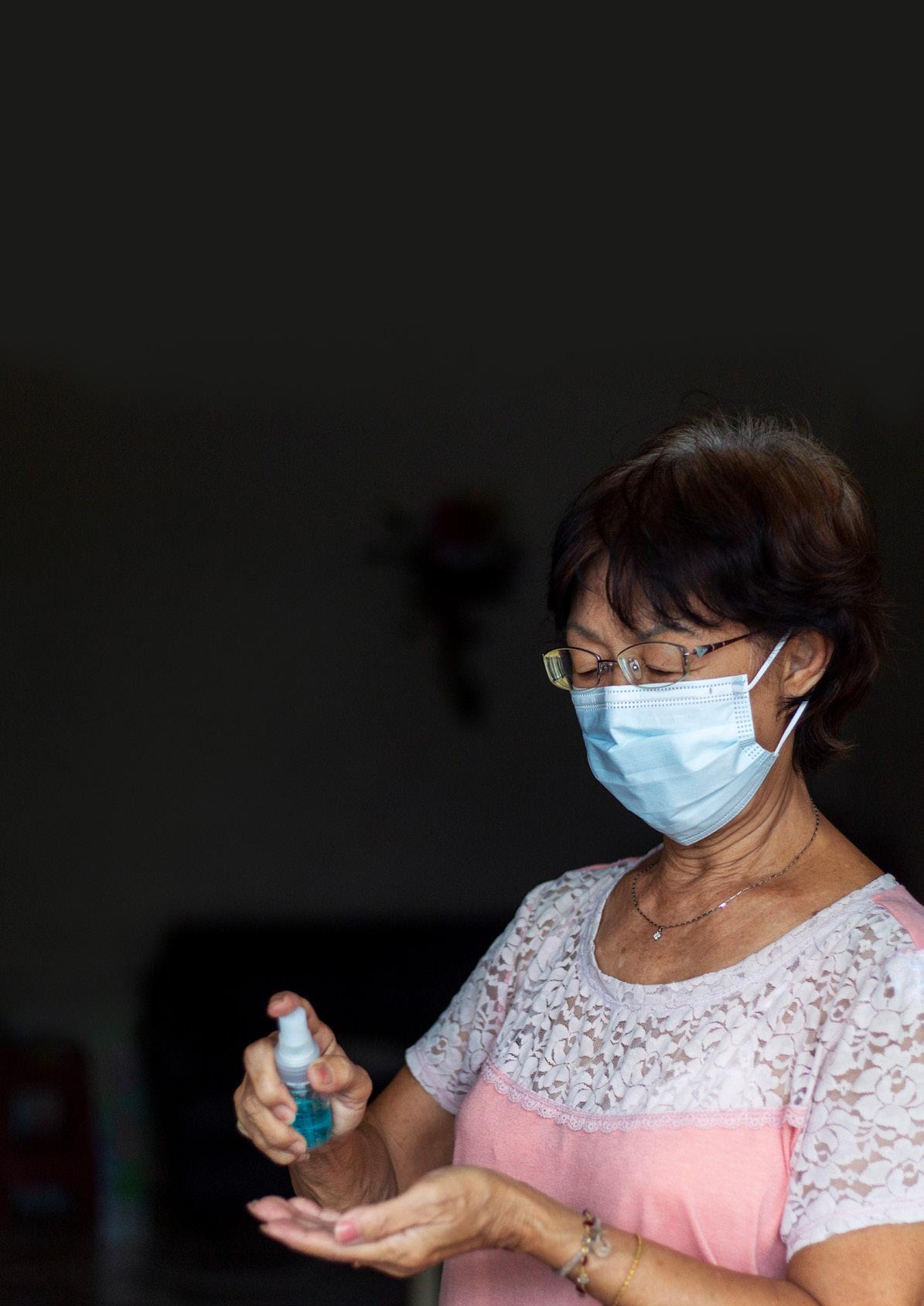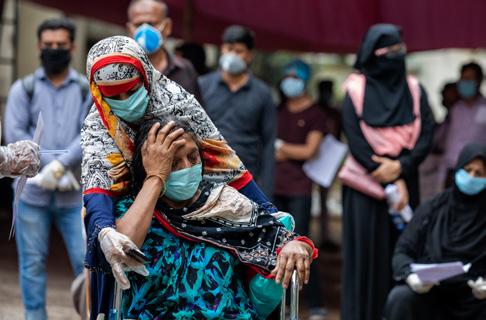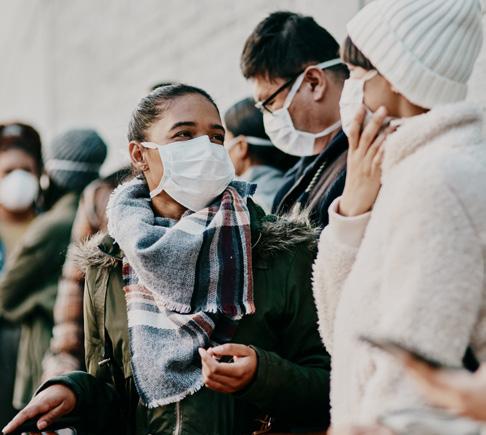
9 minute read
HOW COVID-19 AFFECTS WOMEN
COVID-19 impacts different genders in different ways. In countries where sex-disaggregated COVID-19 mortality data is available, it shows that men are suffering worse outcomes than women. 11 In addition to the physical aspect of the virus, there are a number of other ways in which women and girls are disproportionately, negatively, impacted by COVID-19 and this then links to their ability to be included in the financial system.
Policymakers and regulators need to be mindful of these wider factors and how they impact on women’s financial inclusions opportunities when they are building gender-sensitive considerations in all foundational aspects of their policy and regulatory work. These wider aspects may not be in the direct control of financial policymakers and regulators, but they do directly impact on financial inclusion levels and economic participation.
Advertisement
11 https://blogs.bmj.com/bmjgh/2020/03/24/sex-gender-and-covid-19-disaggregateddata-and-health-disparities/
HEALTH CARE
Women healthcare workers who suffer from workplace violence can suffer a loss of income through missed shifts or taking time off work, for those with an illnesses; they can suffer increased costs if they need to take alternative accommodation for their families to protect them from exposure and can have their opportunities to engage with work reduced because of domestic responsibilities.
Reducing the gender wage gap benefits whole families and protecting women’s and girl’s maternal and sexual health benefits individuals and communities. > The majority of healthcare workers are women; they are more likely to be exposed to a heavy viral load and to work longer hours during a pandemic period.
Healthcare providers are especially vulnerable to
violence and verbal abuse as observed in countries including, United States, Mexico, Philippines, and others. 12
Women are paid less than men 13 for the same
job and have extra pressure with domestic responsibilities, juggling childcare/eldercare, and professional responsibilities.
If women cannot access maternal and sexual health clinics, they and their families are put at risk.
During the West Africa 2014-2016 Ebola outbreak, mortality for pregnant women was 70 percent higher 14 than for those who were not pregnant.
People waiting BSMMU fever clinic outdoor for Covid-19 test in the capital of Bangladesh. April 2020. (Photo by Saikat Bhadra/iStock)

12
13 14 15
16 17 https://www.economist.com/international/2020/05/11/health-workersbecome-unexpected-targets-during-covid-19 https://www.payscale.com/data/gender-pay-gap https://www.ncbi.nlm.nih.gov/pmc/articles/PMC5407292/ https://www.idpublications.org/wp-content/uploads/2015/02/FACTORSCONTRIBUTING-TO-SCHOOL-DROPOUT-AMONG-THE-GIRLS.pdf https://www.worldbank.org/en/topic/girlseducation https://www.cgdev.org/blog/how-will-covid-19-affect-women-and-girlslow-and-middle-income-countries https://www.afi-global.org/blog/2015/01/financial-literacy-importanttool-financial-inclusion
EDUCATION AND LITERACY
Enhancing levels of financial literacy and especially digital financial literacy, can act as enablers in the recovery phase, as women will be more able to engage with new forms of economic activity, as we see economic activity move quickly towards digital forms in sectors that were not traditionally digital.
Supporting literacy levels can assist with opening an account, understanding, and engaging with savings and a wider range of other financial services so that ultimately, an individual is fully financially included. This is particularly important for women as they are more likely to teach this to their children, friends, and other relatives. Equally important is the need to institute consumer awareness, education and literacy programs on DFS.
>
Girls have less access to education 15 than boys and 15 million girls, 16 half of them in Sub-Saharan Africa, will never attend school and can become trapped in a cycle of economic deprivation.
> Girls who are forced to stay at home because of
school closures caused by COVID-19 movement restrictions are less likely to return to school after movement restrictions are lifted. This will significantly impact their life choices and opportunities to engage economically. > Many are pressured to marry at young age and have children whilst they are still children themselves.
Having children at home means that women’s opportunities to work outside the home 17 are reduced as is their earning capacity.
An increase in education levels, especially literacy, is linked to an increase in the rate of formal
financial inclusion later in life. Missing out on schooling will have a long-lasting negative impact and can trap people in cycles of poverty. 18
> Working women are pressured to give up their job
to provide care responsibilities so their partner can continue working. It then may be harder for them to get a new job during a period of recession.
> Women and girls, including those living in displacements, also face additional challenges, particularly, limited access to timely and relevant information and poor health and financial literacy.
This is more pronounced during a pandemic, where they are more socially isolated and further burdened by domestic and care work. Information on outbreaks and available services should be tailored to the diverse needs of these segments of the population and delivered in an inclusive, easy-to-understand and accessible manner.
DOMESTIC CARE AND DOMESTIC WORKERS
The economic value of unpaid care totals $10.8 trillion per year, 19 which is three times larger than the value of the global tech industry.
The impact on women in this sector particularly, is significant and often forces them to risk their health to maintain their job, or to work very long hours to meet expanded domestic care responsibilities, whilst maintaining an income. Their opportunities to save and send remittances are greatly reduced and they are less likely to have high levels of digital financial literacy, thus limiting their opportunities of finding new employment in emerging sectors.
> Most domestic workers and daily wage workers
— predominantly women — are paid in cash, thus exposing them to a greater risk of catching the virus through handling cash and reducing their need to open a formal bank account and engage with other financial services. Movement restrictions will also impact on their ability to reach formal banks and can expose them to physical risks by keeping cash at home or on their person. Their livelihoods and wellbeing are threatened as many of them lose their jobs due to the pandemic.
There are over 67 million women in domestic
work 20 worldwide and movement restrictions will impact their ability to travel for work 21 and their often-precarious employment structures leave them open to abuse, which can impact their ability to send remittances home. 22
> The livelihoods of daily wage workers are now
threatened as they are now out of jobs and many do not have an opportunity to return to their previous form of employment.
INTIMATE PARTNER VIOLENCE (IPV)
From an economic standpoint IPV can cost a nation between one to two percent of national GDP, 23 which if reduced/eradicated can provide a significant boost to the post COVID-19 recovery phase.
Whilst men and boys also do suffer from IPV, it is predominantly women who are the victims. If they are injured, their opportunity to work can be removed and their productivity greatly curtailed. Economic abuse can see them lose control of their finances, which can in turn impact their opportunities, health and wellbeing, as well as that of their children.
Loss of employment, employment restrictions or Movement Control Orders and other forms of
“lockdowns” can put women and children at a
much greater risk of domestic violence (sexual and/ or physical), as we have seen in the New Zealand earthquake, 24 Hurricane Katrina 25 and in China,
Nigeria, 26 the UK and the USA during COVID-19. 27
In 2017, every day, 137 women 28 across the world
were killed by a member of their own family and these numbers are on the rise. If women lack financial means to leave a violent situation, they and their children are at considerable risk of harm or even death.
Individuals who have experienced IPV are likely to be at risk of adverse mental health factors. 29
1-2% GDP
From an economic standpoint IPV can cost a nation between one to two percent of their GDP.

19
20
21
22
23
24 25 26
27
28 https://oxfamilibrary.openrepository.com/bitstream/ handle/10546/620939/bp-sustainable-development-africa-ucdw-030220- en.pdf https://www.ilo.org/global/topics/domestic-workers/who/lang--en/ index.htm https://www.cgdev.org/blog/how-will-covid-19-affect-women-and-girlslow-and-middle-income-countries https://www.ilo.org/asia/media-centre/news/WCMS_632454/lang--en/ index.htm https://www.worldbank.org/content/dam/Worldbank/document/ Gender/Duvvury%20et%20al.%202013%20Intimate%20Partner%20 Violence.%20Economic%20costs%20and%20implications%20for%20 growth%20and%20development%20VAP%20No.3%20Nov%202013.pdf https://journals.sagepub.com/doi/pdf/10.1177/0004865816679687 https://www.ncbi.nlm.nih.gov/pmc/articles/PMC3394178/ https://africa.unwomen.org/en/news-and-events/stories/2020/04/ covid-19-and-the-link-to-violence-against-women-and-girls https://www.who.int/reproductivehealth/publications/emergencies/ COVID-19-VAW-full-text.pdf https://www.unodc.org/documents/data-and-analysis/gsh/Booklet_5. pdf https://www.npr.org/sections/coronavirus-liveupdates/2020/05/14/855894146/some-of-the-greatest-causes-of-miseryu-n-warns-of-pandemic-s-mental-health-cost

WOMEN’S ECONOMIC POWER
Women are less economically powerful and less financially included than men. With the move towards an accelerated adoption of digital financial services, as a response to COVID-19, society may further risk marginalizing women and other vulnerable groups with limited or poor literacy and digital capabilities, and access to reliable and easy-to-understand information.
These groups may not be aware of the resources available to them and the access and skills needed to use these services. They have less opportunity to gain financial resilience, they are less likely to have the same level of savings and these savings are more likely to be informal.
For women who are economically precarious, stockpiling is not an option 30 as it is expensive. > If prices surge women are less economically able to
afford goods and are less able to travel long distances to make purchases if local supply chains have run out of stock.
The household bargaining power 31 a woman holds is linked to both her educational attainment and her labor force participation. > Women’s savings groups can be key in supporting women recover from economic shocks and increase
their financial literacy. They can also be the first step in women’s engagement with the financial system and can encourage them to become more formally engaged and start using a wider range of products and services, such as insurance and pensions.
> There is an opportunity to explore the formalization
and digitization of women’s savings groups and move away from manual processes and systems towards more innovative solutions. Alternative modalities are needed in order to sustain the momentum of these savings groups, which are heavily reliant on regular in-person meetings. It is also important to ensure the less tangible benefits of savings groups are not lost if they move to a digital format.
WOMEN ENTREPRENEURS
Women-owned and run enterprises tend to be smaller, younger and in less profitable economic sectors, with less opportunities to scale.
They can face supply-side constraints, in the form of lack of collateral and unfavorable lending terms when trying to access finance but they also can face some demand-side barriers, such as lower levels of financial literacy, risk aversion, and fear of failure. This all contributes to the sticky nine percent gender gap in access to finance in developing economies. Ensuring women have opportunities to increase their business skills, sustain and grow their businesses and adopt new modalities such as e-commerce will not only help individuals and families not become destitute but will help the whole of society accelerate their economic recovery. Women in the MSME and informal sectors are among the many who are bearing the worst brunt of this pandemic. 32 Formal MSMEs may be pushed into informality to keep their businesses afloat due to challenges in accessing timely and affordable financial support, social and economic protections and cannot access government support packages. They are further bogged down by unpaid care responsibilities, which prevents them from participating in income-generating activities.
> Women entrepreneurs have less experience in
leading businesses and are more likely to operate their enterprises from their homes.
Women have less access to technology to help them
run companies. Nearly 25 percent fewer women than men have access to the Internet. 33
A woman is 25 percent less likely to own a mobile
phone, 34 to have an online presence and are less likely to be able to keep trading if physical stores must close.
> Women are less likely to have significant working
capital/savings to maintain their business during a period of economic lockdown.
> Women are less likely to be able to keep their
staff, if those staff are female and have caring responsibilities.
30
31
32
33 https://www.odi.org/blogs/16754-pandemics-poverty-implicationscoronavirus-furthest-behind https://www.researchgate.net/publication/337292763_Married_ women’s_labor_force_participation_and_intra-household_bargaining_ power https://www.care-international.org/news/press-releases/new-studycovid-19-condemns-millions-of-women-to-poverty-when-they-could-bea-solution-to-prosperity http://www.intel.com/content/dam/www/public/us/en/documents/ pdf/women-and-the-web.pdf http://www.gsma.com/mobilefordevelopment/wp-content/ uploads/2013/01/GSMA_Women_and_Mobile-A_Global_Opportunity.pdf






